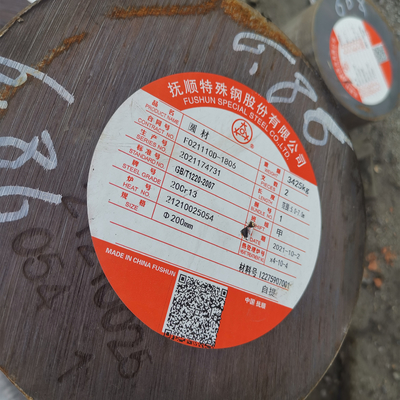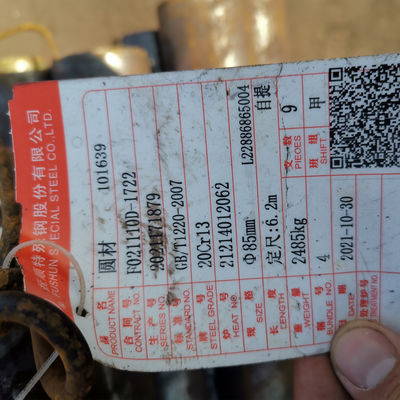Introduction
Grade 420 stainless steel is a high-carbon steel with a minimum chromium content of 12%. Like any other stainless steel, grade 420 can also be hardened through heat treatment. It offers good ductility in its annealed state and excellent corrosion resistance properties when the metal is polished, surface grounded or hardened. This grade has the highest hardness - 50HRC - among all the stainless steel grades with 12% chromium.
Stainless steel grades that are similar to grade 420 stainless steels include martensitic steels such as the other versions of grade 420, having vanadium, sulphur and molybdenum in their composition, and the grade 440 series. Non-standard grade 420C has carbon content that is little higher than that of grade 420.
Martensitic stainless steels are ones with high hardness and high carbon content. These steels are generally fabricated using methods that require hardening and tempering treatments. The operating conditions of martensitic steels are affected by loss of material’s strength at high temperatures, and decrease in ductility at negative temperatures.
Key Properties
The following properties are mentioned for bar products in ASTM A276. The specification may not necessarily be similar for other forms, such as forgings and plate.
Composition
The compositional ranges of grade 420 stainless steels are given in following table:
Table 1 - Compositional ranges of grade 420 stainless steels
|
Grade
|
C
|
Mn
|
Si
|
P
|
S
|
Cr
|
|
420
|
min.
max.
|
0.15
-
|
-
1
|
-
1
|
-
0.040
|
-
0.03
|
12.0
14.0
|
Mechanical Properties
The key mechanical properties of grade 420 stainless steels are tabulated below:
Table 2 - Mechanical properties of grade 420 stainless steels
|
Tempering Temperature (°C)
|
Tensile Strength (MPa)
|
Yield Strength
0.2% Proof (MPa)
|
Elongation (% in 50mm)
|
Hardness Brinell (HB)
|
Impact Charpy V (J)
|
|
Annealed *
|
655
|
345
|
25
|
241 max
|
-
|
|
204
|
1600
|
1360
|
12
|
444
|
20
|
|
316
|
1580
|
1365
|
14
|
444
|
19
|
|
427
|
1620
|
1420
|
10
|
461
|
#
|
|
538
|
1305
|
1095
|
15
|
375
|
#
|
|
593
|
1035
|
810
|
18
|
302
|
22
|
|
650
|
895
|
680
|
20
|
262
|
42
|
|
* Annealed tensile properties are typical for Condition A of ASTM A276; annealed hardness is the specified maximum.
# Tempering of this steel should be avoided in the range 425-600°C
|
Physical Properties
The table below provides the physical properties of grade 420 stainless steels in their annealed state:
Table 3 - Physical properties of annealed grade 420 stainless steels
|
Grade
|
Density (kg/m3)
|
Elastic Modulus (GPa)
|
Mean Coefficient of Thermal Expansion
(μm/m/°C)
|
Thermal Conductivity
(W/m.K)
|
Specific Heat 0-100°C
(J/kg.K)
|
Electrical Resistivity (nΩ.m)
|
|
0-100°C
|
0-315°C
|
0-538°C
|
at 100°C
|
at 500°C
|
|
420
|
7800
|
200
|
10.3
|
10.8
|
11.7
|
24.9
|
-
|
460
|
550
|
Grade Specification Comparison
The proximate grade specifications of 420 stainless steels are given in the table below: (These specifications are for functionally similar materials. Original specifications can be referred to for exact equivalents.)
Table 4 - Grade comparisons of grade 420 stainless steels
|
Grade
|
UNS No
|
Old British
|
Euronorm
|
Swedish SS
|
Japanese JIS
|
|
BS
|
En
|
No
|
Name
|
|
420
|
S42000
|
420S37
|
56C
|
1.4021
|
X20Cr13
|
2303
|
SUS 420J1
|
Corrosion Resistance
Under hardened conditions, grade 420 steels are resistant to fresh water, alkalis, air, foods and mild acids. The steel grades with a smooth surface finish have excellent performance. The corrosion resistance properties of grade 420 will tend to fall under annealed conditions. The corrosion resistance of grade 420 is lower than that of the grade 430 Ferritic alloys with 17% chromium, grade 410 steels and other austenitic grades.
This steel grade finds application in cutlery such as carving knives, table knives and so on. Grade 420 steels have good corrosion resistance against food, but continuous exposure of metals to unwashed food substances can lead to pitting corrosion.
Heat Resistance
Grade 420 stainless steels have a scaling resistance at temperatures of up to 650°C. However, temperatures above standard tempering temperature are not suitable for this grade.
Heat Treatment
Annealing – Grade 420 stainless steels can be heated at temperatures from 840 to 900°C, followed by slow furnace cooling at 600°C and then air-cooling.
Process Anneal – Grade 420 can be annealed at 735 to 785°C and air-cooled.
Hardening – This process involves heating grade 420 steels at 980 to 1035°C, followed by air or oil quenching. Oil quenching is usually preferred for heavy metal sections. Tempering is performed at 150 to 370°C to achieve high hardness and good mechanical properties. Grade 420 should not be tempered between 425 and 600°C.
Welding
Grade 420 stainless steels are welded using welding rods, coated with grade 420 metals, to achieve high-strength joints. During the process, steels are pre-heated at 150 to 320°C and post-heated to 610 to 760°C. In the “as welded” condition, parts are welded using grade 309 filler rods to achieve ductile joints. However, grade 309 electrodes or rods are recommended for welding grade 420 steels by AS 1554.6.
Machining
Grade 420 steels can be easily machined in their annealed state, but they are difficult to machine having a hardness greater than 30HRC. One of the most readily available machined alternatives is the free-machining grade 416 steels.
Applications
The key applications of grade 420 stainless steels include:
- Shear blades
- Needle valves
- Surgical equipment
- Cutlery




 Your message must be between 20-3,000 characters!
Your message must be between 20-3,000 characters! Please check your E-mail!
Please check your E-mail!  Your message must be between 20-3,000 characters!
Your message must be between 20-3,000 characters! Please check your E-mail!
Please check your E-mail! 





